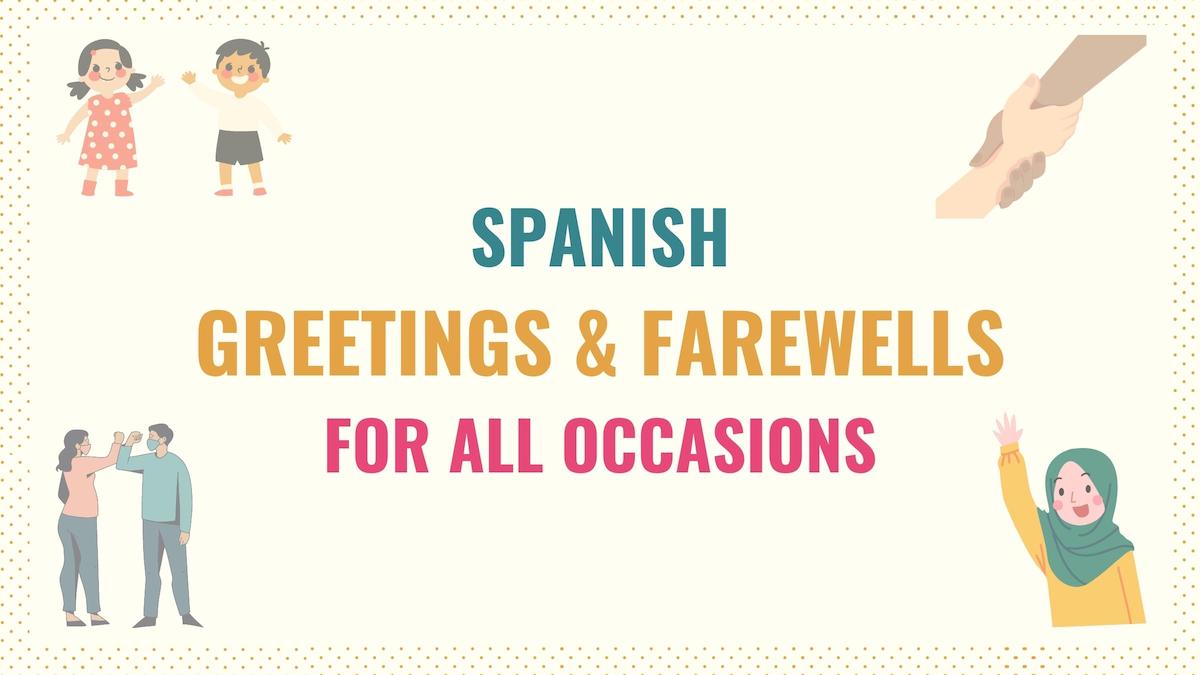Whether you’re just starting out or looking to polish your skills, mastering Spanish greetings is crucial for opening conversations. So, in this article, you’ll learn key farewells and greetings in Spanish that you can use in different situations.
Here is what we’ll cover:
I’ve included recordings so you can check how to pronounce these Spanish greetings and goodbyes.
Greeting People in Spanish
Below you’ll find lists of phrases you can use for greeting people in Spanish based on the environment or situation.
Basic Greetings in Spanish
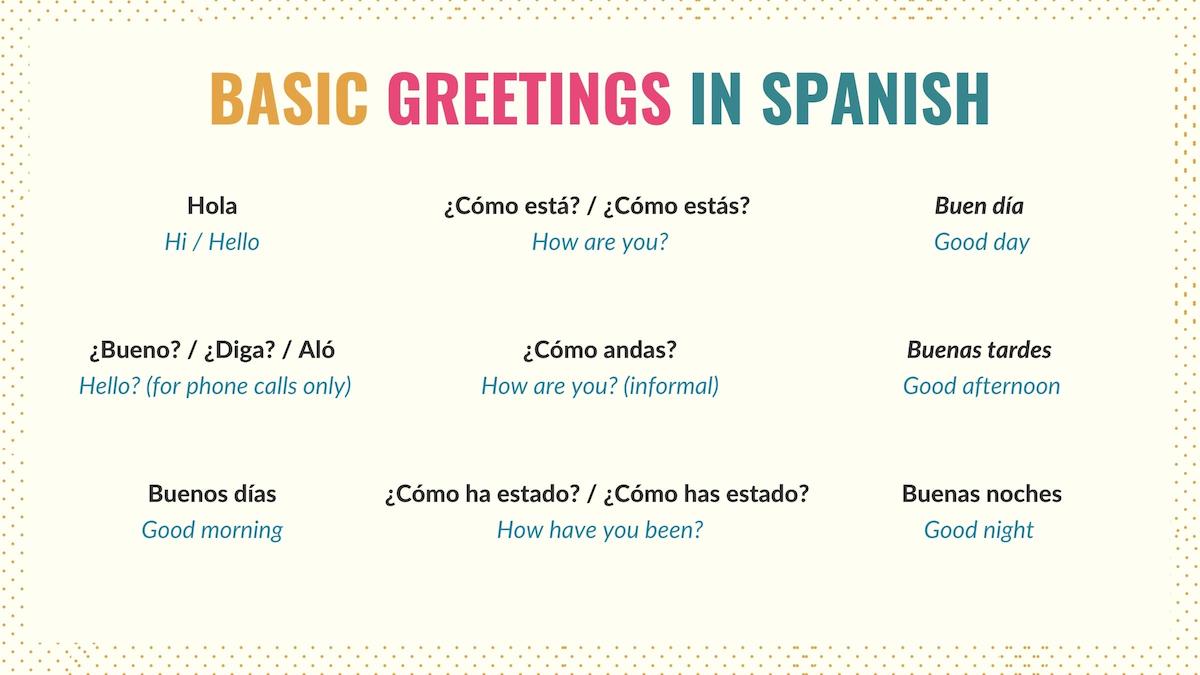
- Hola – Hi / Hello
- ¿Bueno? / ¿Diga? / Aló – Hello? (for phone calls only)
- Buenos días – Good morning
- Buen día – Good day
- Buenas tardes – Good afternoon
- Buenas noches – Good night / Good evening
You can also add the following basic phrases to your Spanish greeting:
- ¿Cómo está? / ¿Cómo estás? – How are you?
- ¿Cómo andas? – How are you? (informal)
- ¿Cómo ha estado? / ¿Cómo has estado? – How have you been?
Take Note: Although they share the same English translation, ¿cómo está? and ¿cómo estás? are used to address a person formally or informally. These phrases are an example of what is known as informal and formal Spanish.
Greetings in Spanish
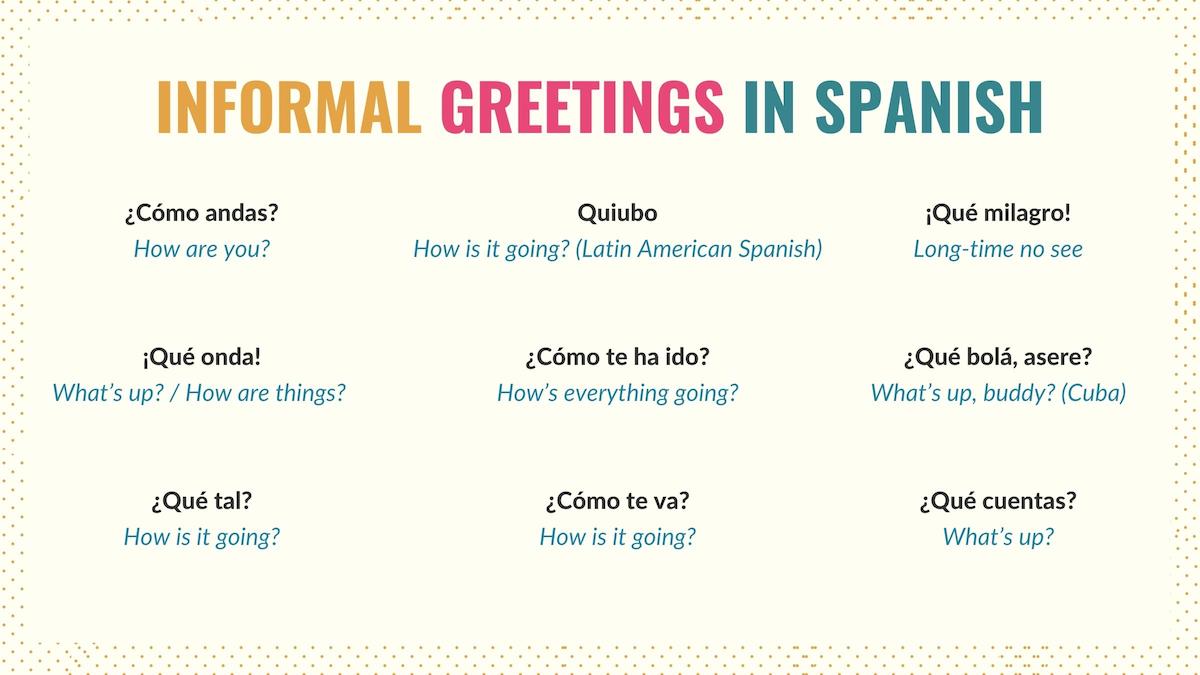
If you are greeting friends, family members, or acquaintances, you can use any of the following Spanish expressions and words:
- ¿Cómo andas? – How are you?
- ¡Qué onda! – What’s up? / How are things?
- ¿Qué tal? – How is it going?
- Quiubo – How is it going? (Latin American Spanish)
- ¿Cómo te ha ido? – How’s everything going?
- ¿Cómo te va? – How is it going?
- ¡Qué milagro! – Long-time no see
- ¿Qué bolá, asere? – What’s up, buddy? (Cuba)
- ¿Qué cuentas? – What’s up?
Formal Spanish Greetings
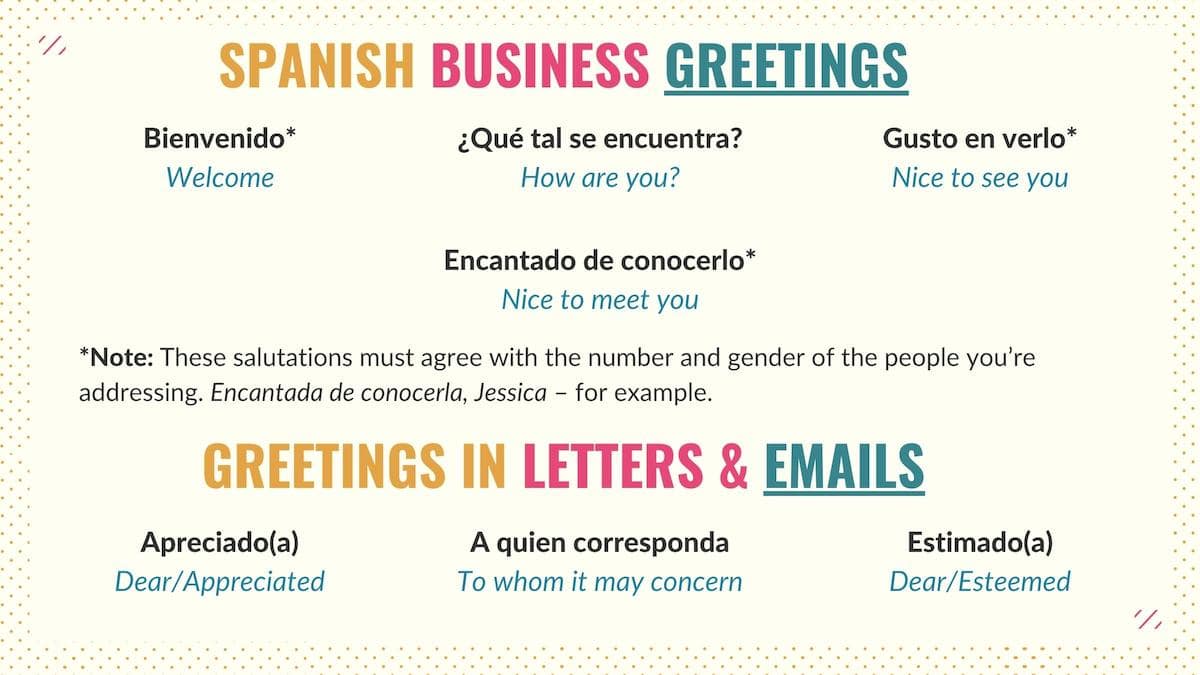
- Bienvenido* – Welcome
- ¿Qué tal se encuentra? – How are you?
- Gusto en verlo* – Nice to see you
- Encantado de conocerlo* – Nice to meet you
*Note: These expressions must agree with the number and gender of the person you’re addressing. Encantada de conocerla, Jessica – for example.
If you must talk to people through a written channel, you can use any of these email greetings:
- Apreciado(a): Dear/Appreciated
- A quien corresponda: To whom it may concern
- Estimado(a): Dear/Esteemed
Tip: On top of a greeting, other basic elements can help you improve your written messages, such as writing the date correctly and using appropriate connecting words. If you want to learn more about writing letters or emails, you can check my article on how to write a letter in Spanish.
Spanish Christmas Greetings
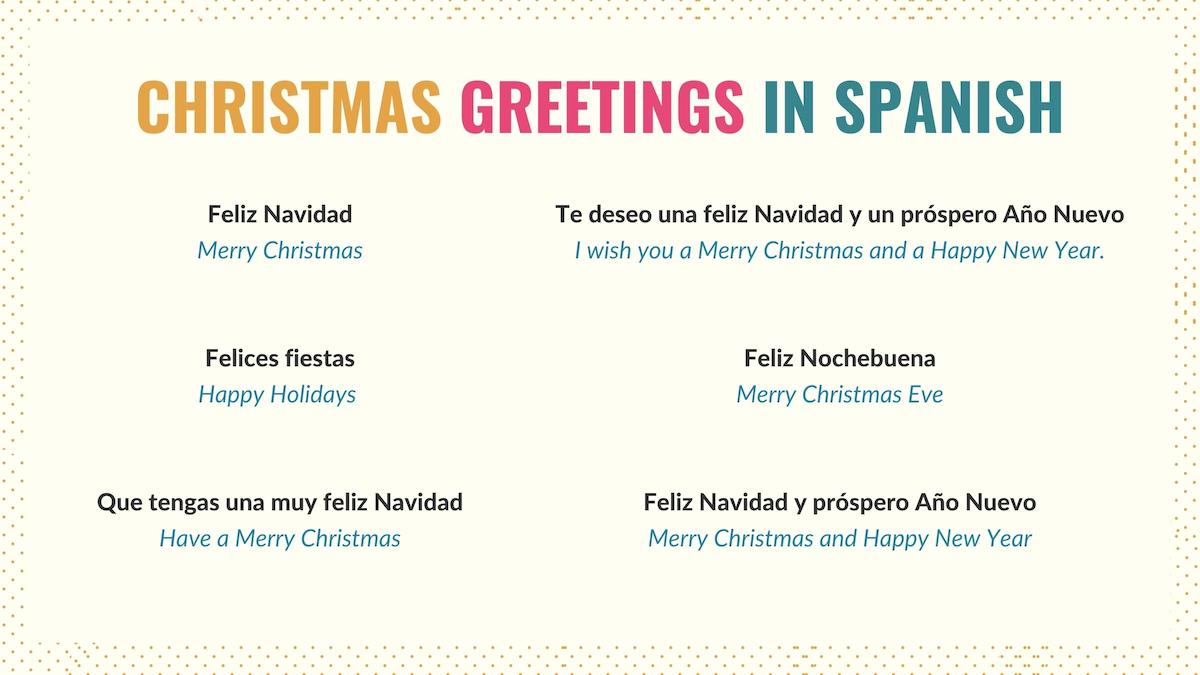
Although it only takes place once a year, here are a few Christmas greetings you can use in Spanish:
- Feliz Navidad – Merry Christmas.
- Felices fiestas – Happy Holidays.
- Que tengas una muy feliz Navidad – Have a Merry Christmas.
- Te deseo una feliz Navidad y un próspero Año Nuevo – I wish you a Merry Christmas and a Happy New Year.
- Feliz Nochebuena – Merry Christmas Eve.
- Feliz Navidad y próspero Año Nuevo – Merry Christmas and Happy New Year.
Take Note: Feliz and felicidades are basic words to congratulate someone in Spanish.
Key Birthday Greetings
Some basic birthday greetings and wishes you can use in Spanish include:
- Feliz cumpleaños – Happy birthday
- ¡Felicidades! – Congratulations
- ¡Que tengas un feliz cumpleaños! – Have a happy birthday
- Espero que te la pases bien – I hope you have a nice time
- Te deseo lo mejor – I wish you the best
- Feliz cumple – Happy birthday (informal)
- ¡Muchas felicidades! – Congratulations
- Felicidades en tu día – Congratulations on your day
If you have a fellow Spanish speaker’s birthday party or celebration to attend in the near future, I’ve gone into more depth on ways to wish someone a happy birthday. Feel free to check it out.
Common Ways to Say Goodbye in Spanish
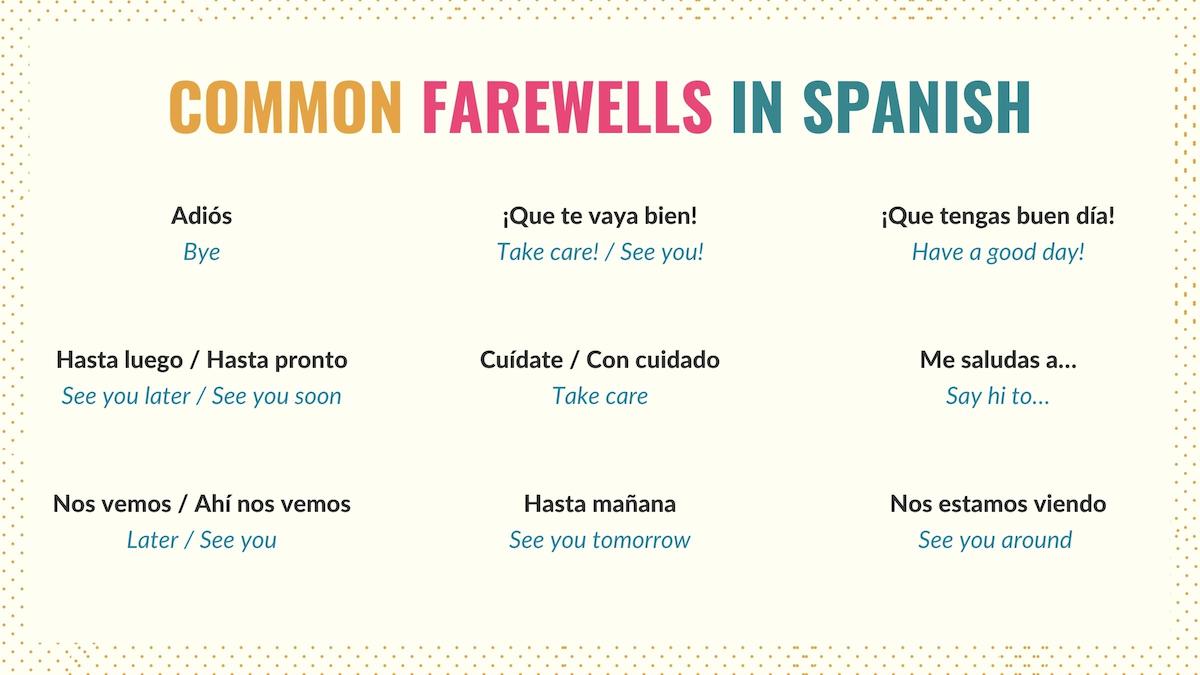
Now that you know how to greet people, here are some key Spanish farewells that will make you sound more natural:
- Adiós – Bye
- Hasta luego / Hasta pronto – See you later / See you soon
- Nos vemos / Ahí nos vemos – Later / See you
- ¡Que tengas buen día! – Have a good day!
- ¡Que te vaya bien! – Take care! / See you!
- Cuídate / Con cuidado – Take care
- Hasta mañana* – See you tomorrow
- Me saludas a… – Say hi to…
- Nos estamos viendo – See you around
Tip: In the expressions hasta luego or hasta mañana, you can replace ‘mañana’ and ‘luego’ with a day of the week or a noun to express when you’re seeing that person again. For example, hasta el lunes (see you on Monday).
For formal letters or emails, consider these Spanish farewells:
- Atentamente – Sincerely
- Quedo a sus órdenes – I remain at your service
- Un saludo cordial – Kindest regards
- Le agradezco de antemano – Thank you in advance
Bonus: Spanish Greetings and Responses
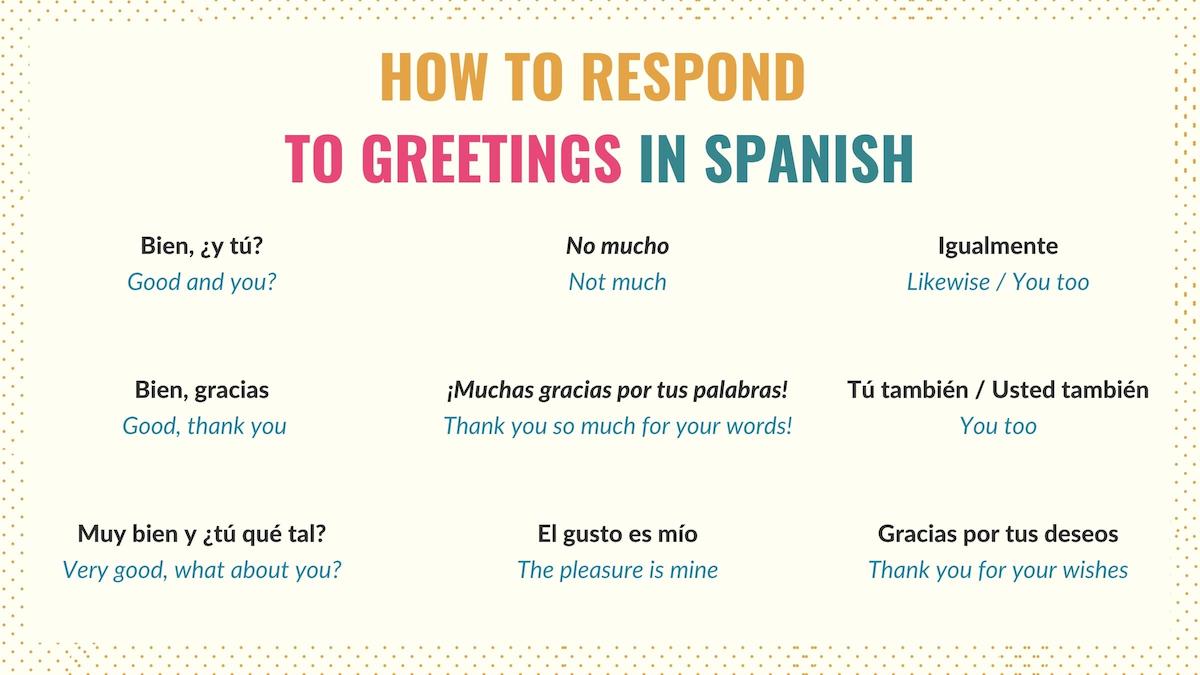
Here are some common phrases you can use to respond to a greeting in Spanish. Note that some of these options may be more suitable for certain greetings than others:
- Bien, ¿y tú? – Good and you?
- Bien, gracias – Good, thank you
- Muy bien y ¿tú qué tal? – Very good, what about you?
- No mucho – Not much
- ¡Muchas gracias por tus palabras! – Thank you so much for your words!
- El gusto es mío – The pleasure is mine
- Igualmente – Likewise / You too
- Tú también / Usted también – You too
- Gracias por tus deseos – Thank you for your wishes
- Feliz Navidad para ti también – Merry Christmas to you too
Here are some examples:
| Spanish | English |
|---|---|
| Que tenga buen día. | Have a good day. |
| Gracias, usted también. | Thank you, you too! |
In many cases, the easiest way to reply to a greeting or farewell in Spanish is by reciprocating with a salutation.
| Spanish | English |
|---|---|
| ¡Hola, chicos! | Hi guys! |
| ¡Qué onda, Debbie! ¿Cómo andas? | What’s up, Debbie? How are you? |
Next Steps: Resources to Learn Spanish
Now that you’ve acquired this basic vocabulary, there are other resources you can check to improve your Spanish. As a long-time teacher and native speaker, I can tell you that greetings and farewells can vary significantly across different Spanish-speaking countries.
If you’re focusing on Mexican Spanish, you should check this curated list of Mexican greetings. Additionally, if you want to expand your vocabulary, you may also want to check:
Download the Spanish Farewells & Greetings PDF
To get the most out of this vocabulary, you’ll need to practice them over time. Study at your own pace by downloading the PDF with all the greetings and farewells included above.

